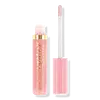What's inside
What's inside
 Key Ingredients
Key Ingredients

 Benefits
Benefits

 Concerns
Concerns

 Ingredients Side-by-side
Ingredients Side-by-side

Petrolatum
EmollientPolyisobutene
Caprylic/Capric Triglyceride
MaskingPentaerythrityl Tetraisostearate
EmollientMethyl Methacrylate Crosspolymer
PEG-8 Beeswax
EmulsifyingSqualane
EmollientSilica
AbrasiveTribehenin
EmollientPhenoxyethanol
PreservativeTocopheryl Acetate
AntioxidantSimmondsia Chinensis Seed Oil
EmollientHelianthus Annuus Seed Oil
EmollientSalvia Hispanica Seed Oil
MoisturisingParfum
MaskingIsohexadecane
EmollientRetinyl Palmitate
Skin ConditioningBHT
AntioxidantEthylene/Propylene/Styrene Copolymer
Butylene/Ethylene/Styrene Copolymer
Sodium Hyaluronate
HumectantXanthan Gum
EmulsifyingTocopherol
AntioxidantTripeptide-1
Skin ConditioningBenzyl Benzoate
AntimicrobialCI 77891
Cosmetic ColorantIron Oxides
Petrolatum, Polyisobutene, Caprylic/Capric Triglyceride, Pentaerythrityl Tetraisostearate, Methyl Methacrylate Crosspolymer, PEG-8 Beeswax, Squalane, Silica, Tribehenin, Phenoxyethanol, Tocopheryl Acetate, Simmondsia Chinensis Seed Oil, Helianthus Annuus Seed Oil, Salvia Hispanica Seed Oil, Parfum, Isohexadecane, Retinyl Palmitate, BHT, Ethylene/Propylene/Styrene Copolymer, Butylene/Ethylene/Styrene Copolymer, Sodium Hyaluronate, Xanthan Gum, Tocopherol, Tripeptide-1, Benzyl Benzoate, CI 77891, Iron Oxides
Polybutene
Octyldodecanol
EmollientOctyldodecyl Stearoyl Stearate
EmollientSilica Dimethyl Silylate
EmollientTriethylhexanoin
MaskingTriisodecyl Trimellitate
EmollientIsocetyl Stearate
EmollientDiisostearyl Malate
EmollientPentaerythrityl Tetraisostearate
EmollientPhenylpropyldimethylsiloxysilicate
EmollientGlyceryl Behenate/Eicosadioate
EmollientElaeis Guineensis Oil
EmollientGossypium Herbaceum Seed Oil
Skin ConditioningBidens Pilosa Extract
HumectantLinum Usitatissimum Seed Oil
PerfumingTocopherol
AntioxidantDiethylhexyl Syringylidenemalonate
Skin ProtectingCaprylic/Capric Triglyceride
MaskingTocopheryl Acetate
AntioxidantEthyl Vanillin
MaskingCalcium Sodium Borosilicate
Calcium Aluminum Borosilicate
Silica
AbrasiveSynthetic Fluorphlogopite
Mica
Cosmetic ColorantTin Oxide
AbrasiveCI 77891
Cosmetic ColorantCI 77491
Cosmetic ColorantCI 15850
Cosmetic ColorantCI 19140
Cosmetic ColorantCI 45410
Cosmetic ColorantCI 42090
Cosmetic ColorantPolybutene, Octyldodecanol, Octyldodecyl Stearoyl Stearate, Silica Dimethyl Silylate, Triethylhexanoin, Triisodecyl Trimellitate, Isocetyl Stearate, Diisostearyl Malate, Pentaerythrityl Tetraisostearate, Phenylpropyldimethylsiloxysilicate, Glyceryl Behenate/Eicosadioate, Elaeis Guineensis Oil, Gossypium Herbaceum Seed Oil, Bidens Pilosa Extract, Linum Usitatissimum Seed Oil, Tocopherol, Diethylhexyl Syringylidenemalonate, Caprylic/Capric Triglyceride, Tocopheryl Acetate, Ethyl Vanillin, Calcium Sodium Borosilicate, Calcium Aluminum Borosilicate, Silica, Synthetic Fluorphlogopite, Mica, Tin Oxide, CI 77891, CI 77491, CI 15850, CI 19140, CI 45410, CI 42090
 Reviews
Reviews

Ingredients Explained
These ingredients are found in both products.
Ingredients higher up in an ingredient list are typically present in a larger amount.
This ingredient is an emollient, solvent, and texture enhancer. It is considered a skin-softener by helping the skin prevent moisture loss.
It helps thicken a product's formula and makes it easier to spread by dissolving clumping compounds.
Caprylic Triglyceride is made by combining glycerin with coconut oil, forming a clear liquid.
While there is an assumption Caprylic Triglyceride can clog pores due to it being derived from coconut oil, there is no research supporting this.
Learn more about Caprylic/Capric TriglycerideCi 77891 is a white pigment from Titanium dioxide. It is naturally found in minerals such as rutile and ilmenite.
It's main function is to add a white color to cosmetics. It can also be mixed with other colors to create different shades.
Ci 77891 is commonly found in sunscreens due to its ability to block UV rays.
Learn more about CI 77891Pentaerythrityl Tetraisostearate is derived from isostearic acid. It is an emollient and emulsifier.
The highest concentration of this ingredient is found in lipsticks.
This ingredient is minimally water soluble and may not be Malassezia folliculitis, or fungal-acne safe.
Learn more about Pentaerythrityl TetraisostearateSilica, also known as silicon dioxide, is a naturally occurring mineral. It is used as a fine, spherical, and porous powder in cosmetics.
Though it has exfoliant properties, the function of silica varies depending on the product.
The unique structure of silica enhances the spreadability and adds smoothness, making it a great texture enhancer.
It is also used as an active carrier, emulsifier, and mattifier due to its ability to absorb excess oil.
In some products, tiny microneedles called spicules are made from silica or hydrolyzed sponge. When you rub them in, they lightly polish away dead skin layers and enhance the penetration of active ingredients.
Learn more about SilicaTocopherol (also known as Vitamin E) is a common antioxidant used to help protect the skin from free-radicals and strengthen the skin barrier. It's also fat soluble - this means our skin is great at absorbing it.
Vitamin E also helps keep your natural skin lipids healthy. Your lipid skin barrier naturally consists of lipids, ceramides, and fatty acids. Vitamin E offers extra protection for your skin’s lipid barrier, keeping your skin healthy and nourished.
Another benefit is a bit of UV protection. Vitamin E helps reduce the damage caused by UVB rays. (It should not replace your sunscreen). Combining it with Vitamin C can decrease sunburned cells and hyperpigmentation after UV exposure.
You might have noticed Vitamin E + C often paired together. This is because it is great at stabilizing Vitamin C. Using the two together helps increase the effectiveness of both ingredients.
There are often claims that Vitamin E can reduce/prevent scarring, but these claims haven't been confirmed by scientific research.
Learn more about TocopherolTocopheryl Acetate is AKA Vitamin E. It is an antioxidant and protects your skin from free radicals. Free radicals damage the skin by breaking down collagen.
One study found using Tocopheryl Acetate with Vitamin C decreased the number of sunburned cells.
Tocopheryl Acetate is commonly found in both skincare and dietary supplements.
Learn more about Tocopheryl Acetate